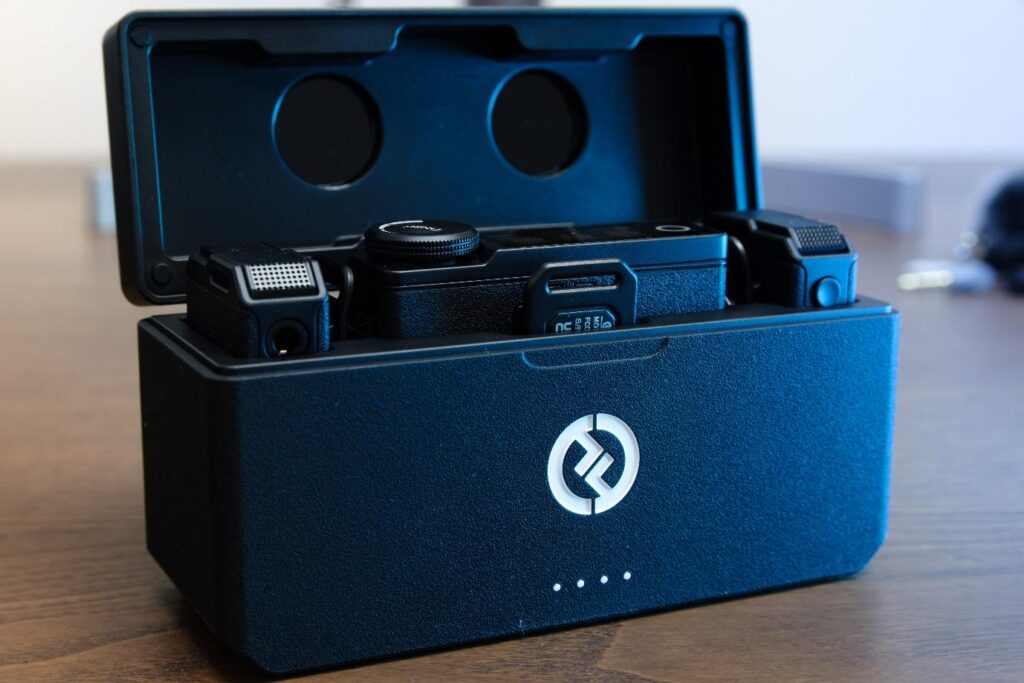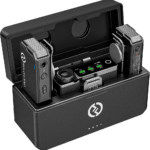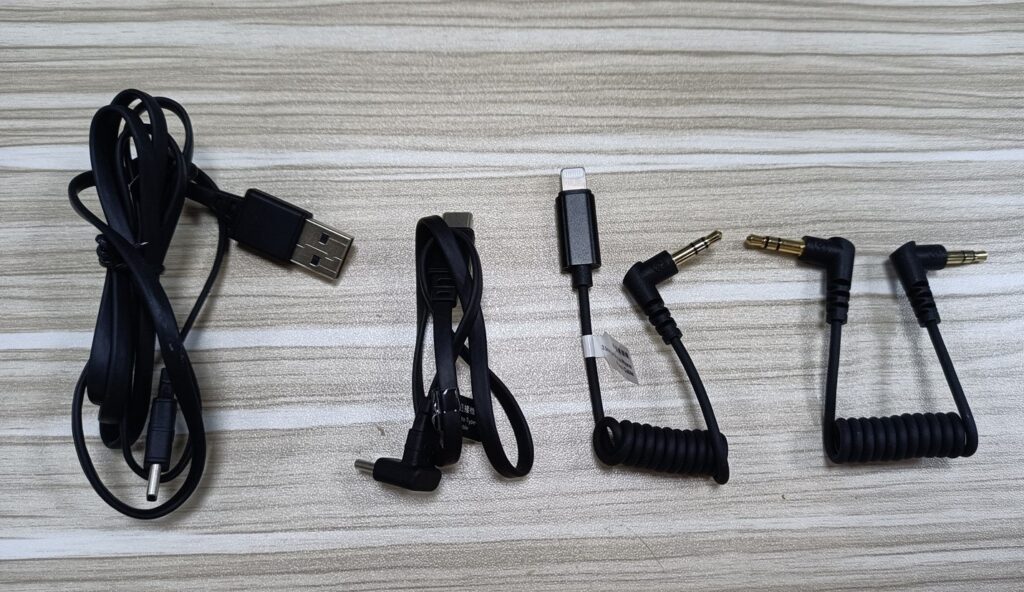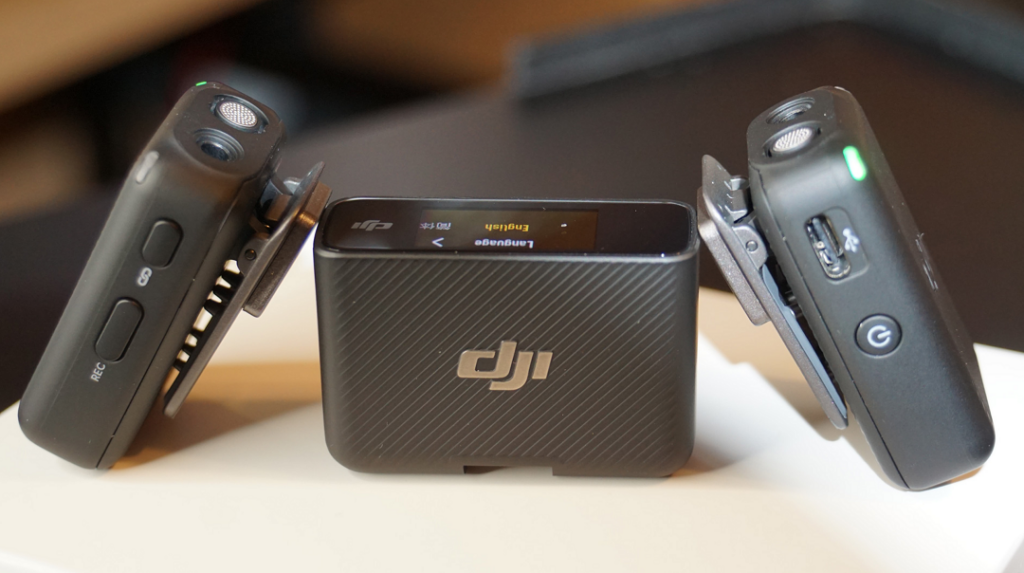The Hollyland Lark Max is the latest offering from Hollyland Technologies. It’s the latest entry into the upper-entry segment of wireless microphone systems, which Rode once dominated. The Hollyland Lark Max is an upgrade of the Lark 150, and in this discussion, we’re going to pit it against another strong product – the DJI Mic.
The DJI Mic would always be measured against the industry benchmark Rode’s Go. The question is, how’s the Lark Max going to measure up to the DJI Mic? In this discussion, we’re going to find that out.
We’ll put the DJI Mic and the Hollyland Lark Max in similar situations and figure out which one comes out better in terms of performance. We’ll also look at the features on paper and compare them to establish which suits you better.
Without further ado, let’s get started.


This is a quick comparison chart of the two mics side by side for you –
| DJI Mic | Hollyland Lark Max | |
| Price | $329 (2 TX + 1 RX) | $299 (2 TX + 1 RX) |
| Technology | ||
| Wireless Technology | 2.4 GHz | 2.4 GHz |
| Transmitters (TX) | 2 | 2 |
| Receivers (RX) | 1 | 1 |
| RF channel scanning | 2400 to 2483.5 MHz | 2400MHz~2483.5MHz |
| Maximum operating range (with line of sight) | 820 feet or 250 meters | 820 feet or 250 meters in a clear line of sight. 60 meters in a blocked area. |
| Built-in recorder option | Yes | Yes |
| Encryption | Yes – proprietary | Yes – proprietary |
| Modulation | GFSK | GFSK |
| Receiver (RX) | ||
| Receiver mounting options | Hot shoe mount and plug-in option | Hot shoe mountable. 3.5mm TRS plug-in option available. |
| Maximum number of audio channels | 2 | 2 |
| Audio ports | 3.5mm TRS female output – 13.5mm TRS female output for headphones – 1 | 3.5mm TRS female output – 1. |
| USB ports | One expansion port compatible with the Lightning and the USB-C adapters. | USB-C Male – 1. USB-C to Lightning and USB-C to USB-C cables are provided. |
| Audio output level | -12 to +12 dB | -10dB to +10dB |
| Frequency response range | 50 Hz to 20 kHz | 20 Hz to 20 kHz |
| Power source | Rechargeable Lithium batteries | LIPO-ROHS |
| Internal battery capacity | 320 mAh | 490 mAh |
| Approximate working time on a full charge | 5 hours | 9 hours |
| Total charging time for battery. | 160 minutes | < 2 hours |
| Display | OLED touchscreen with a full display of menu items, including battery charge status. | AMOLED indicator with an array of information, including battery charge status, recording status, |
| Weight | 24.9 grams | 60 grams |
| Transmitter (TX) | ||
| Design | Clip-on option with built-in microphone and recorder. | Clip-on design with built-in microphone and recorder. A magnet attachment option is also available. |
| RF output power option | 100mW | |
| Audio port | 3.5mm TRS female input – 1 | 3.5mm TRS female input for Lavalier mic. |
| Audio level control | None | Yes |
| Recorder sample rates | 48 kHz | 48 kHz |
| Recorder bit depths | 24-Bit | 24-Bit |
| Memory card option | None | None |
| Internal recording | 14 hours | |
| Audio file format | WAV | WAV lossless |
| Sync method | Proprietary | Proprietary |
| Antenna | Internal | Internal |
| Power source | Rechargeable Lithium batteries | Rechargeable LIPO-ROHS |
| Internal battery capacity | 320 mAh | 300 mAh |
| Approximate working time on a full charge | 5.5 hours | 7.5 hours |
| Total charging time for battery. | 70 minutes | < 2 hours |
| Weight | 30 grams | 33 grams |
| Microphone | ||
| Microphone type | Integrated | Integrated |
| Sound field | Mono | Mono |
| Capsule | Electret condenser | |
| Polar pattern | Omnidirectional | Omnidirectional |
| Equivalent noise level | 23 dB A-weighted | |
| Maximum SPL | 114 dB SPL | 120dBSPL (by default), up to 128dBSPL |
| Charging Case | ||
| Battery type | Rechargeable Lithium batteries | LIPO-ROHS |
| Internal battery capacity | 2600 mAh | 2800 mAh |
| Approximate working time on a full charge | 15 hours | 2 full charges of the TXs and RX. |
| Total charging time for battery. | 2 hours | 2 hours |
| Weight | 162.2 grams | 202 grams |
| Charging interface | USB-C | USB-C |
Read More: Hollyland Lark Max Review: The Next Generation Wireless Microphone System

Wireless Microphone with Studio Audio.
Connectivity
The DJI Mic has a range of connectivity options, including 3.5mm TRS input, so you can plug in headphones and monitor the sound while recording. There is also an option to plug the TX of the DJI Mic onto a camera’s hot shoe and then plug the 3.5mm out to connect to a camera’s 3.5mm input for recording the audio directly to a camera. There are options to plug in a USB type C cable or a Lightning cable as well to the expansion port that allows you to connect any smartphone – Android or iPhone and use that to record the audio directly onto your camera.
The Lark Max matches all those options. Plus, you get all the required cables and adapters in the box, so you don’t have to spend additional money on these accessories. You’re ready to shoot as soon as you unbox your Lark Max.
Compatibility
The Lark Max is designed to work with most cameras and phones. The provided cables, such as the TRS to TRRS, TRS to TRS, the USB-C to USB-C, and USB-C to Lightning digital cable, along with the correct ports, ensure that the system is compatible with any kind of device that you may have.

The DJI Mic is also compatible with many devices, including any phone using Lightning or USB-C ports. You will need to plug in the correct adapter at the expansion port at the bottom of the receiver, and then you should be able to connect it to your device.
The system can be plugged into a camera’s hot shoe, and then you can plug in a 3.5m TRS cable to connect your camera to the DJI Mic.
The DJI Mic and the Lark Max offer a significantly more extensive range of options to plug into cameras and phones. Also, it must be noted that the Lark Max comes with several additional cables, improving its versatility by making it compatible with many systems.
Number of transmitters
The Hollyland Lark Max and the DJI Mic have a twin TX system paired with a single RX. Of course, there is a single RX and TX option for the DJI Mic, but we picked the dual TX version for fairness in this comparison. Both systems come with a portable carrying cum charging case.


Frequency
The frequency response range of the Lark Max is 20Hz to 20kHz. Comparatively, the frequency response range of the DJI Mic is 50Hz to 20kHz. However, this is a vague way to simply mention the frequency response range without a frequency curve to back things up. We’ll limit ourselves to state that the frequency response range of the Lark Max is slightly bigger, which means it can output a larger range of sounds.
Wireless range
The Hollyland Lark Max has a maximum working distance of 250 meters (or 820 feet) with a clear line of sight—the same as the DJI Mic. The wireless range of the Lark Max and the DJI Mic are much better parameters than the Rode Go. The Rode Wireless Go II has a maximum line of sight operation of 656 feet. The original wireless go had an even lower operating range.
Many of you may feel that the 250 meters of the wireless range may sound like something other than a practical edge because there is rarely a situation when you would be using it. Honestly, the terrace where we tested the Lark Max did not allow us to test its full wireless range.
But having said that, if you’re a YouTube content creator or someone who shoots videos from a distance, this extended range will come in handy. Any obstacles or interferences in the area where the TXs are will hamper the range and the audio quality.
Control and interface
One of the best things about the Lark Max is the extensive control functions built into the TXs and the RX. It has to because the DJI Mic also comes with a handy touchscreen interface that allows the user to control a bunch of operations. This is one of the primary reasons why the DJI Mic became so popular among users who compared it with the Rode Wireless Go.
The Lark Max also has a touch interface and can do everything the DJI Mic does. The Lark Max’s TX and RX also have several buttons and a rotary dial to supplement the touch interface.
You can change the OLED display screen’s brightness, making it easier to see under a glaring summer sky. The display offers a range of information, including the battery status on the two TXs and the input volume.
The RX allows a single button to enable noise cancellation, muting, and recording, making it easy for anyone to monitor the audio from the camera end.
The RX also has an equalizer functionality allowing you to tweak things like voice reinforcement and enable the low-cut mode or the Hi-Fi mode.
Sound quality
When the DJI Mic was announced in 2022, the main focus of attention was how good the audio quality would be. Portability was never an issue considering DJI’s brand. Despite the price being a little higher, videographers, YouTubers, and content creators were looking for audio quality that was crisp and reliable performance. That’s where the DJI Mic came short. The audio quality left us a little disappointed. Especially when recording outside a controlled environment like a room.
Another thing that we noticed with the DJI Mic was that although the design of the TX was to work as the primary lav mic without the need to plug in another lav mic into them, the audio quality can be a little disappointing when they’re attached to your shirt collar. It feels like the person speaking is talking in a different direction, and the audio is a little suppressed. This was not noticed when the mic was hand-held close to the speaker’s mouth. We’d imagine that handholding is not how the TX was designed to work primarily.
Also, the dead cats with DJI Mic are not that good. In a windy environment, some wind noise still seeps through, which can be a significant factor for some users, especially if you’re a moto-vlogger and need a wireless mic to record with your camera.
The main focus that Hollyland had was on bettering the audio quality of the Lark 150 and its main competitor, the DJI Mic. There was no doubt that they would be able to offer the same range and the same portability.
During our tests, the Hollyland Lark Max performed appreciably to the extent that I am prepared to give my vote to the Lark Max in terms of audio quality alone. We tested it out on a terrace, and the vehicular movement and the construction sounds from a nearby building were well-damped.
Since the first set of testing we did during the initial review of the Lark Max, we even got the opportunity to test it out in a crowded street to check the audio quality and the performance of the ambient noise cancellation feature.
While at it, we also got to check the effect of other devices using the same 2.4GHz spectrum. Our test showed that the Lark Max performed admirably well in drowning out the ambient noise. And thanks to the advanced Automatic Frequency Hopping technology, we did not experience significant interferences while working in a signal-heavy location.
When working inside a room with Bluetooth and Wi-Fi devices all around it, the Lark Max performed admirably well.
But wait! How about impeccable sound quality in a small, hidden wireless microphone that weighs just 7 grams? Hollyland has given all content creators the biggest surprise of 2025 by launching the Lark M2S. Its titanium clip-on build makes it the epitome of durability, while its logo-free design is like the icing on the cake, ensuring your identity always shines before the brand.
Battery life
The TX of the DJI Mic is powered by a 320mAh rechargeable battery that allows it to record up to 5.5 hours of audio. A full charge requires 70 minutes. The Hollyland Lark Max outdoes that, with its TX lasting 7.5 hours of recording time on a single charge.
The internal battery of the RX of the DJI Mic is also a 320mAh unit that lasts 5 hours on a full charge. A full charge requires 160 minutes. Compared to that, the Hollyland Lark Max’s RX can last for 9 hours on a single charge. The 490mAh battery can be fully charged in about less than 2 hours.
Though both the units come with a charging cum carrying case, and they can charge them quickly, the real thing that matters is how long the TXs and the RX last when working – and in that segment, the Hollyland Lark Max wins the race.
To be fair to the DJI Mic, the system has enough juice to recharge the TXs and the RX for a maximum of 14 hours of recording time. The Lark Max, on the other hand, can charge the TXs and the RX two times over. That means you can get 15 working hours from the Lark Max’s TX and 18 hours from the RX.
Durability and build quality
One of the major improvements that users loved the DJI Mic for was the build quality. Compared to something like the Rode Go, the build quality is great, and especially the charging case was a huge hit. Not only was it built solid it earned a lot of brownie points for being both convenient and practical.
One of the major issues Rode Go users have complained about is that the TXs often get lost inside their bags, which can be quite a hassle. The DJI Mic, with its charging case, changed all that. In that sense, the Lark Max, with its convenient and powerful charging case, offers the same level of experience and customer satisfaction.
The build quality and power retention of the charging case was major challenge for the Hollyland Lark Max to beat. We have already reviewed the Lark C1, the Lark M1, and also the Lark 150, and the charging cases were simple yet functional. The build quality was good. The Lark Max carries forward that simplicity in design, and the build quality is good to compete with the DJI Mic.
Let’s quickly look at the weight of the TXs from the DJI Mic and the Lark Max. The DJI Mic’s TXs weigh 30 grams. On the other hand, the TXs of the Lark Max weighs 33 grams. Not much of a difference to talk about. They’re both very lightweight systems.
On the other hand, the RX of the DJI Mic weighs 24.9 grams, significantly lighter than the 60 grams of the Lark Max’s weight. At the end of the day, the dimensions of the Lark Max’s RX are much bigger than the one of the DJI Mic – 58×40.83×23.17mm as against 47.4 x 32.2 x 17.3 mm. As long as you have the TX mounted on a camera, the ‘extra’ weight will not matter.
Price and availability
The DJI Mic is priced at $329, making it significantly higher than some other alternatives available. Yes, there are other options that you can look into, from the Rode Wireless II and even Hollyland’s own range of wireless systems. The Lark Max offers the same features, a more extensive working time frame, and greater compatibility. Both systems are available worldwide at major online and offline stores.

Wireless Microphone with Studio Audio.






























.png)





